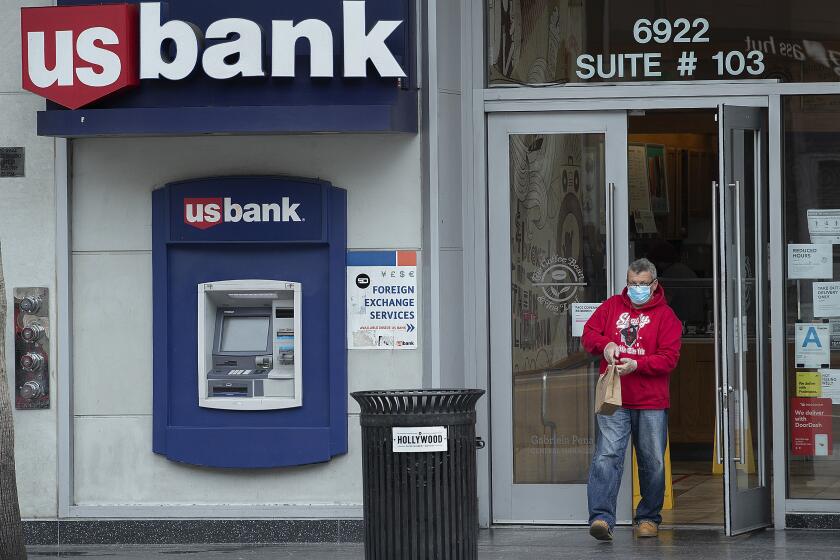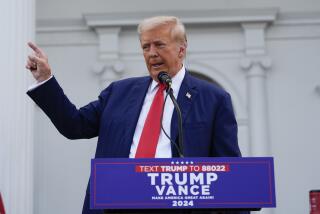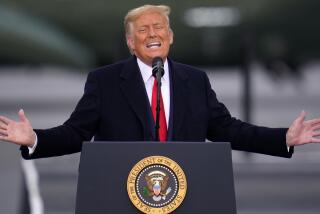Trump stokes up his blame game for the coronavirus

- Share via
WASHINGTON — Repeatedly declaring his authority over states is “total,” President Trump let loose a tirade of grievances and accusations Monday even as governors on both the West and East Coasts made clear they weren’t following White House cues and began making plans to ease restrictions to the coronavirus pandemic on a regional basis.
After a weekend fuming and tweeting about what he saw as negative news coverage, Trump staged one of the strangest yet of his near-nightly White House briefings, angrily claiming he had been “brutalized” by the media and playing a White House-produced campaign-style reel of selectively edited video clips of officials effusively praising his efforts.
The often-testy briefing underscored the dissonance between beleaguered state and local officials and medical authorities on the front lines of a public health catastrophe and a president in the throes of a legacy-defining crisis who continues to use a prism of unwavering self-regard, insisting that he “calls the shots” even as he scapegoated others — especially the media — for any problems or delays.
These are some of the unusual new scenes across the Southland during the coronavirus outbreak.
“You’re so disgraceful,” he told a CBS News reporter who questioned him about his early actions. “You know you’re a fake, you know that.”
Trump peppered his comments with inaccurate claims, insisting that “nobody” had asked for ventilators, although numerous governors had repeatedly requested them in the month since he declared a national emergency.
“Everything we did was right,” Trump said. “Governors should have had ventilators, they chose not to have them. We chose to get them ventilators. They got the ventilators.”
He also called Dr. Anthony Fauci, the nation’s top expert on infectious diseases, to the lectern to walk back his comment on a Sunday TV talk show that earlier U.S. efforts to fight the coronavirus “could have saved lives,” a statement that Trump clearly found objectionable.
In response, Fauci called his answer “hypothetical,” adding that he wasn’t suggesting “that maybe something was at fault here.”
He said Trump had not directed him to do so, and Trump — who on Sunday had retweeted a supporter who had added “#FireFauci” to a post praising the administration’s early response to the crisis — later said he had no intention of firing Fauci, who enjoys far higher approval ratings than the president in opinion polls.
In any case, those urging Trump to fire Fauci overestimate the president’s ability to do so.
“He can’t just fire him. He’s a career employee,” said Max Stier, president and chief executive of the Partnership for Public Service, a nonprofit, nonpartisan organization that focuses on improving efficiency of the federal government.
Civil service protections were created precisely to protect government employees from political retaliation. Fauci has led the infectious disease unit at the National Institutes of Health since 1984, serving presidents in both parties.
Trump also insisted Monday that he, not governors and mayors, will decide when to “open up the states,” a claim at odds with reality but in line with his effort to claim credit for any positive developments while blaming others for any problems.
After leaving it to state and local authorities to order millions of Americans to stay at home, a confused process that has created patchwork rules around the country, Trump tweeted that reopening the economy “is the decision of the President,” and not the officials who shouldered the responsibility of closing most schools, shops and nonessential services.
Asked during the briefing which provisions would authorize him to override local officials, Trump was vague. “Numerous provisions,” he said. “We’ll give you a legal brief if you want.”
“When somebody is the president of the United States, the authority is total,” he said. When another reporter asked him why he believed that to be true, he quickly shushed her — “Enough, please!” he said.
Several governors took a different view of executive authority, signaling Monday that they are working with one another to plan when and how to ease restrictions and reopen local businesses, in part because no federal plan exists despite Trump’s assertions.
California Gov. Gavin Newsom and his counterparts in Washington and Oregon will work together on a plan to lift restrictions and reopen economies along the West Coast, while six Northeastern states announced a similar plan to coordinate.
Trump’s determination to be credited for the eventual decision to “reopen” the economy, even though governors, mayors, corporate chief executives and consumers ultimately will determine that, aligns with his instincts as a promoter, said Michael D’Antonio, the author of the 2015 biography, “The Truth About Trump.”
“He is treating this as if the nation is a hotel that had been closed for renovation and is going to have a grand reopening and everyone should be invited,” he said.
Timothy Naftali, a presidential historian at New York University, said the coronavirus crisis offered Trump “an opportunity that doesn’t often come to presidents” not just to show growth but to show commanding leadership and to bring the country together.
“He failed, because he’s never been able to get beyond himself,” Naftali said. “He shouldn’t be wasting an ounce of energy on feuds. But it’s Trump against the world all the time.”
Trump’s briefings have amply displayed his thin-skinned response to any implied criticism, and his seemingly insatiable need for praise and validation. He has used them to blame China, the World Health Organization, former President Obama, Democrats and others.
In recent weeks, he has lashed out at governors who criticized the federal response, suggesting he may withhold aid to those who aren’t “appreciative” enough, and repeatedly claimed that first responders are “happy” with his efforts despite widespread reports of bottlenecks, shortages and frustration.
The White House now is considering cutting U.S. funding for the WHO , the United Nations agency responsible for international public health, for acting too slowly to raise the alarm against the pandemic — the same criticism that many level against Trump.
The president’s nightly boasts and accusations help obscure the administration’s slow initial response and several still-unfulfilled promises made during the outbreak.
When Trump declared a national emergency in the Rose Garden on March 13, for example, he promised to quickly create a website in collaboration with Google that would allow anyone to identify a local testing site for the coronavirus, and to set up drive-through test sites outside Walmarts and other major retailers. Neither has happened on any scale.
Trump’s efforts to claim false credit, and his need for both sycophants and scapegoats, are hardly new. But they have intensified during the coronavirus crisis as he, like most Americans, has been largely locked inside, watching as the death toll steadily creeps up.
As a result, Trump has been increasingly consumed with what he views as negative news coverage, according to four people who spoke with him in recent days, all of whom spoke on the condition of anonymity. He appeared to spend most of the weekend watching, and tweeting about, reports he saw on cable TV.
Trump’s focus, the people said, has been primarily on stories about his own performance. As he has let off steam to his nearly 77 million Twitter followers, he has grumbled privately to allies, complaining at one point about New York Gov. Andrew Cuomo receiving more favorable news coverage than he has, one person said.
The latest updates from our reporters in California and around the world
“He sits around and he watches the news, and he needs to stop doing that,” said Barry Bennett, a former campaign advisor for Trump.
Bennett said Trump’s instinct to assign blame and lash out at critics is borne of frustration.
“He typically controls the news cycle. Now he’s just participating in the news cycle because nobody wants to talk about anything else other than COVID-19,” he said.
Times staff writer Jennifer Haberkorn contributed to this report.
More to Read
Get the L.A. Times Politics newsletter
Deeply reported insights into legislation, politics and policy from Sacramento, Washington and beyond. In your inbox three times per week.
You may occasionally receive promotional content from the Los Angeles Times.















